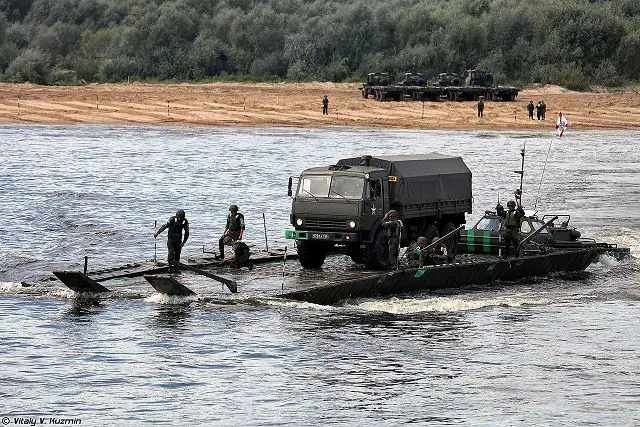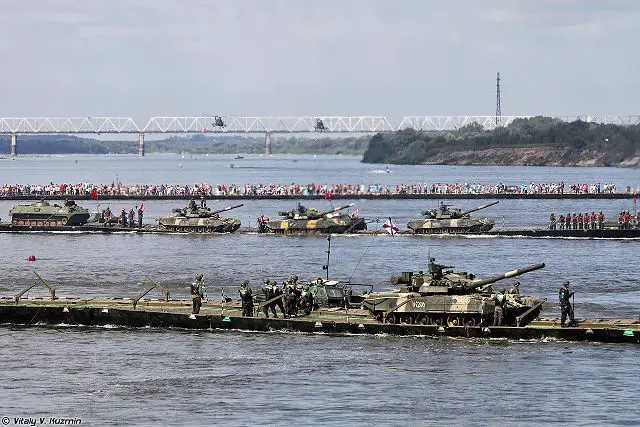|
|
|||
|
Armies in the world - Russian army
|
|||
|
|
|||
| At military exercise Caucasus 2016 Russian armed forces tested latest river crossing equipment. | |||
|
At the recent Caucasus 2016 exercise, the Russian Armed Forces tested the latest river crossing equipment, according to the Izvestia daily. During the crossing of the Don River by tank and infantry units, the Defense Ministry tested the unique BMK towboat designed to tow ferries and reconnoiter water bodies for setting up bridge or ferry crossing sites.
|
|||
|
|
|||
 Russian team transports KAMAZ-43114 with PMP pontoon bridge and BMK-460 boat (Picture Vitaly Kuzmin) Russian team transports KAMAZ-43114 with PMP pontoon bridge and BMK-460 boat (Picture Vitaly Kuzmin) |
|||
|
|
|||
|
The Defense Ministry has reported that a 600-m-long float bridge was deployed as part of the maneuvers in the Prudboi Training Area near Volgograd, with the troops to be able to cross the Don without preparations. The maneuver was supported by two advanced BMK pontoon boats from the Volga Shipyard (VSSZ) and KAMPO JSC. The military has not ordered such equipment for over 20 years.
The Defense Ministry explained that the new towboats supported the linking of the units of pontoon bridges. The BMK features high transportability (it has to fit the bed of the KamAZ truck) and high throttle response with the minimal weight and draught, which affords it maneuverability in the shallows and in the face of broken ice. The BMK looks like an ordinary outboard with a two-person cabin. At less than 8 m long and a weight of a bit more than 3.5 tons, the towboat can for 11 hours tow pontoons and fix them in position or carry four troops and small cargo. Mention should be made that it has passed the preliminary tests and Exercise Caucasus 2016 has shown how the BMK performs in battle. According to KAMPO Spokeswoman Ulyana Zakharova, the BMK was conceived as a means of motorizing all pontoon trains in the combat engineers’ inventory - from the combined-arms ones (PMP, PMP-M, PP-91, PP-2005) to special ones (PPS-84). Its characteristics enable it to replace any previous-generation BMK. |
|||
|
|
|||
 T-80 main battle tank carried on a floating bridge (Picture Vitaly Kuzmin) T-80 main battle tank carried on a floating bridge (Picture Vitaly Kuzmin) |
|||
|
|
|||
|
"The development of a new boat has come into the foreground owing to the ongoing upgrade of the inventory of the combat engineers, in particular, the fielding of them with up-to-date crossing equipment." Zakharova said. "The preliminary trials looked into the boat’s ability to be launched from and loaded onto its truck and to perform tasks afloat both alone and while towing a pontoon using various techniques, with the pontoon carrying various vehicles, e.g. a T-80 tank. The tests have been conducted at night and in the daytime."
According to VSSZ Spokesman Pavel Glukhov, many of the requirements the Russian Corps of Engineers set to the BMK were hard to meet. The boat had to have the assigned dimensions, weight, draught and speed while displaying high towing effectiveness. The requirements have been met owing to the hull’s thing walls and bottom, a complex shape and small compartments. Every gram of weight counted for the structural strength to be preserved. According to Lieutenant General Yuri Stavitsky, the chief of the combat engineers, his branch has recently updated its inventory considerably, using to advanced engineer hardware and personal gear. The materiel in question includes bridge-layers, pontoon trains, man-portable landmine sensors, robotized surveillance systems for combat engineer reconnaissance and explosive ordnance disposal, a sawmill, truck-mounted cranes and many other equipment that has not been mentioned in recent combat gear employment reports, Stavitsky has told the Izvestia daily. |
|||
At military exercise Caucasus 2016 Russian armed forces tested latest river crossing equipment TASS 11510161
- Posted On














